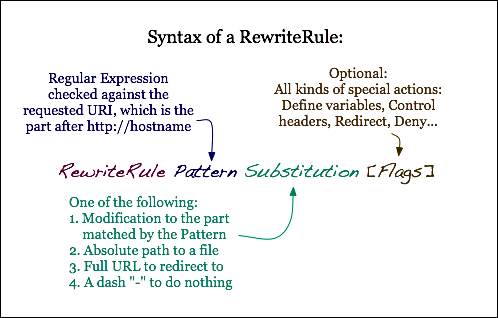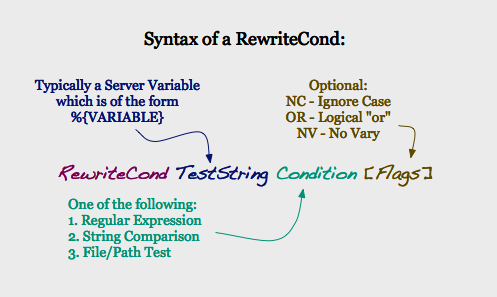Раздел 4. URL Rewriting Guide
Пункт 35. Introduction to regular expressions and mod_rewrite
This document supplements the mod_rewrite
reference documentation. It
describes the basic concepts necessary for use of
mod_rewrite . Other documents go into greater detail,
but this doc should help the beginner get their feet wet.
Introduction
The Apache module mod_rewrite is a very powerful and
sophisticated module which provides a way to do URL manipulations. With
it, you can do nearly all types of URL rewriting that you may need. It
is, however, somewhat complex, and may be intimidating to the beginner.
There is also a tendency to treat rewrite rules as magic incantation,
using them without actually understanding what they do.
This document attempts to give sufficient background so that what follows is understood, rather than just copied blindly.
Remember that many common URL-manipulation tasks don't require the
full power and complexity of mod_rewrite . For simple
tasks, see mod_alias and the documentation
on mapping URLs to the
filesystem.
Finally, before proceeding, be sure to configure
mod_rewrite 's log level to one of the trace levels using
the LogLevel directive. Although this
can give an overwhelming amount of information, it is indispensable in
debugging problems with mod_rewrite configuration, since
it will tell you exactly how each rule is processed.
Regular Expressions
mod_rewrite uses the Perl Compatible Regular Expression vocabulary. In this document, we do not attempt to provide a detailed reference to regular expressions. For that, we recommend the PCRE man pages, the Perl regular expression man page, and Mastering Regular Expressions, by Jeffrey Friedl.
In this document, we attempt to provide enough of a regex vocabulary
to get you started, without being overwhelming, in the hope that
RewriteRule s will be scientific
formulae, rather than magical incantations.
Regex vocabulary
The following are the minimal building blocks you will need, in order
to write regular expressions and RewriteRule s. They certainly do not
represent a complete regular expression vocabulary, but they are a good
place to start, and should help you read basic regular expressions, as
well as write your own.
| Character | Meaning | Example |
|---|---|---|
. | Matches any single character | c.t will match cat ,
cot , cut , etc. |
+ | Repeats the previous match one or more times | a+ matches a , aa ,
aaa , etc |
* | Repeats the previous match zero or more times. | a* matches all the same things
a+ matches, but will also match an empty string. |
? | Makes the match optional. |
colou?r will match color and colour . |
^ | Called an anchor, matches the beginning of the string | ^a matches a string that begins with
a |
$ | The other anchor, this matches the end of the string. | a$ matches a string that ends with
a . |
( ) | Groups several characters into a single unit, and captures a match for use in a backreference. | (ab)+
matches ababab - that is, the + applies to the group.
For more on backreferences see below. |
[ ] | A character class - matches one of the characters | c[uoa]t matches cut ,
cot or cat . |
[^ ] | Negative character class - matches any character not specified | c[^/]t matches cat or c=t but not c/t |
In mod_rewrite the ! character can be
used before a regular expression to negate it. This is, a string will
be considered to have matched only if it does not match the rest of
the expression.
Regex Back-Reference Availability
One important thing here has to be remembered: Whenever you
use parentheses in Pattern or in one of the
CondPattern, back-references are internally created
which can be used with the strings $N and
%N (see below). These are available for creating
the Substitution parameter of a
RewriteRule or
the TestString parameter of a
RewriteCond .
Captures in the RewriteRule patterns are (counterintuitively) available to
all preceding
RewriteCond directives,
because the RewriteRule
expression is evaluated before the individual conditions.
Figure 1 shows to which locations the back-references are transferred for expansion as well as illustrating the flow of the RewriteRule, RewriteCond matching. In the next chapters, we will be exploring how to use these back-references, so do not fret if it seems a bit alien to you at first.

Figure 1: The back-reference flow through a rule.
In this example, a request for
/test/1234 would be transformed into /admin.foo?page=test&id=1234&host=admin.example.com .
RewriteRule Basics
A RewriteRule consists
of three arguments separated by spaces. The arguments are
- Pattern: which incoming URLs should be affected by the rule;
- Substitution: where should the matching requests be sent;
- [flags]: options affecting the rewritten request.
The Pattern is a regular expression. It is initially (for the first rewrite rule or until a substitution occurs) matched against the URL-path of the incoming request (the part after the hostname but before any question mark indicating the beginning of a query string) or, in per-directory context, against the request's path relative to the directory for which the rule is defined. Once a substitution has occurred, the rules that follow are matched against the substituted value.

Figure 2: Syntax of the RewriteRule directive.
The Substitution can itself be one of three things:
- A full filesystem path to a resource
-
RewriteRule "^/games" "/usr/local/games/web"
This maps a request to an arbitrary location on your filesystem, much like the
Aliasdirective. - A web-path to a resource
-
RewriteRule "^/foo$" "/bar"
If
DocumentRootis set to/usr/local/apache2/htdocs, then this directive would map requests forhttp://example.com/footo the path/usr/local/apache2/htdocs/bar. - An absolute URL
-
RewriteRule "^/product/view$" "http://site2.example.com/seeproduct.html" [R]
This tells the client to make a new request for the specified URL.
The Substitution can also contain back-references to parts of the incoming URL-path matched by the Pattern. Consider the following:
RewriteRule "^/product/(.*)/view$" "/var/web/productdb/$1"
The variable $1 will be replaced with whatever text
was matched by the expression inside the parenthesis in
the Pattern. For example, a request
for http://example.com/product/r14df/view will be mapped
to the path /var/web/productdb/r14df .
If there is more than one expression in parenthesis, they are
available in order in the
variables $1 , $2 , $3 , and so
on.
Rewrite Flags
The behavior of a RewriteRule can be modified by the
application of one or more flags to the end of the rule. For example, the
matching behavior of a rule can be made case-insensitive by the
application of the [NC] flag:
RewriteRule "^puppy.html" "smalldog.html" [NC]
For more details on the available flags, their meanings, and examples, see the Rewrite Flags document.
Rewrite Conditions
One or more RewriteCond
directives can be used to restrict the types of requests that will be
subject to the
following RewriteRule . The
first argument is a variable describing a characteristic of the
request, the second argument is a regular
expression that must match the variable, and a third optional
argument is a list of flags that modify how the match is evaluated.

Figure 3: Syntax of the RewriteCond directive
For example, to send all requests from a particular IP range to a different server, you could use:
RewriteCond "%{REMOTE_ADDR}" "^10\.2\."
RewriteRule "(.*)" "http://intranet.example.com$1"
When more than
one RewriteCond is
specified, they must all match for
the RewriteRule to be
applied. For example, to deny requests that contain the word "hack" in
their query string, unless they also contain a cookie containing
the word "go", you could use:
RewriteCond "%{QUERY_STRING}" "hack"
RewriteCond "%{HTTP_COOKIE}" "!go"
RewriteRule "." "-" [F]
Notice that the exclamation mark specifies a negative match, so the rule is only applied if the cookie does not contain "go".
Matches in the regular expressions contained in
the RewriteCond s can be
used as part of the Substitution in
the RewriteRule using the
variables %1 , %2 , etc. For example, this
will direct the request to a different directory depending on the
hostname used to access the site:
RewriteCond "%{HTTP_HOST}" "(.*)"
RewriteRule "^/(.*)" "/sites/%1/$1"
If the request was for http://example.com/foo/bar ,
then %1 would contain example.com
and $1 would contain foo/bar .
Rewrite maps
The RewriteMap directive
provides a way to call an external function, so to speak, to do your
rewriting for you. This is discussed in greater detail in the RewriteMap supplementary documentation.
.htaccess files
Rewriting is typically configured in the main server configuration
setting (outside any <Directory> section) or
inside <VirtualHost>
containers. This is the easiest way to do rewriting and is
recommended. It is possible, however, to do rewriting
inside <Directory>
sections or .htaccess
files at the expense of some additional complexity. This technique
is called per-directory rewrites.
The main difference with per-server rewrites is that the path
prefix of the directory containing the .htaccess file is
stripped before matching in
the RewriteRule . In addition, the RewriteBase should be used to assure the request is properly mapped.


